- Home
- All Kinds of Palms
- Types of Outdoor Palms
Types of Outdoor Palm Trees
The Complete Guide for Your Zone
Many types of outdoor palm trees could fit your own landscape. Let's see what we need to know for varied palm tree types.
Why Grow Palm Trees Outdoors?
People sometimes wonder "should I put my palm tree outside?" So, why grow palms outdoors?
- For their tropical aesthetics and stunning landscaping impact, creating a lush ambience.
- They enhance curb appeal, and are adaptable in coordinating with your home.
- They are adaptable to varied environments and climates. Growing in botanical gardens, outdoor containers, coastal communities, and desert landscapes. All besides their beauty in the tropics.
- And most of all - it's their natural environment.
Some types of outdoor palm plants are best for creating privacy. If you're looking for a bush-type of palm, step right up! In fact, those two types together can even create some shade.
Let's get into the various types of outdoor palm trees.
Feeling overwhelmed by so many palm trees?
You're not alone. We Understand your headaches! At Mission: Palm Trees you'll find clear answers to questions & Step-By-Step Guidance, from real people. With solutions to help. No puzzling shoptalk. No tiring research. So it's easy & fun for you.
Category of Palm Tree Sizes
 Decisions - Decisions - We'll Guide You!
Decisions - Decisions - We'll Guide You!Palms come in a variety of size ranges.
You can select from compact varieties perfect for small yards to towering species as a property statement. It's just important to consider Advance Planning for Your Chosen Palm.
For using types of palms outdoor, an understanding their mature height and crown width is essential for a good fit in the future. We're categorizing palms by size to help you narrow down the best options for your outdoor setting.
And then you can go from there!
Are There Palm Trees That Stay Small?
Small palms, which are often called dwarf palms, are usually 10–20ft/3-6m tall.
Some other little known palms in this category are even smaller! These types of palm trees for gardens are ideal for tight landscapes and patio & walkway borders. Growing them in containers for outdoor placement is practical, for carting indoors when needed.
Here is a selection that can work for your landscape.
Pygmy Date Palm Outdoors
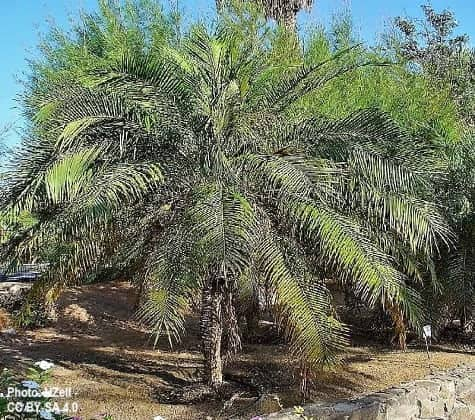 Nice looking small palm - don't you think?
Nice looking small palm - don't you think?Phoenix roebelenii is petite, getting from 10-15ft/3-4.5m tall.
A pygmy palm tree outdoors is its best placement. It's graceful and elegant.
An advantage is it's self-cleaning. Ideal for zones 19b–11 that get decent rainfall or watering. Can work in 8b with arid climates.
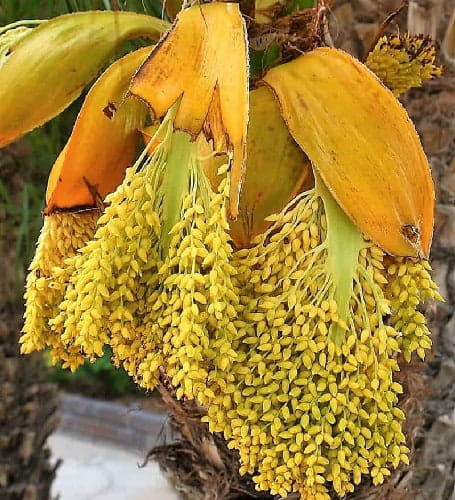 Flowering Pygmy Date Palm
Flowering Pygmy Date PalmEuropean Fan Palm
Chamaerops humilis grows in a clumping formation that can spread as much as 30ft/9m wide.
The European Fan Palm height gets 20ft/6m tall. Flexible and hardy, best in zones 8–11. Plus it's a drought tolerant palm, once it's established.
 Also called Mediterranean Fan Palm
Also called Mediterranean Fan PalmCan You Plant a Cat Palm Outside?
Since Chamaedorea cataractarum is native to Mexican rain forests, it's ideal for growing outside.
Native near rivers and streams. That gives you a clue to its water needs, which are high. It grows somewhat quickly. Ideal for USDA climate zones 9b-11.
How big does a cat palm tree get? It's possible to reach 6ft/1.8m tall.
Shrubby clumping style with a very short trunk. Excellent for shaded spots: the more sun it gets, the more water it needs!
Can be nicely used for outdoor patio-side screening, as it's short but full.
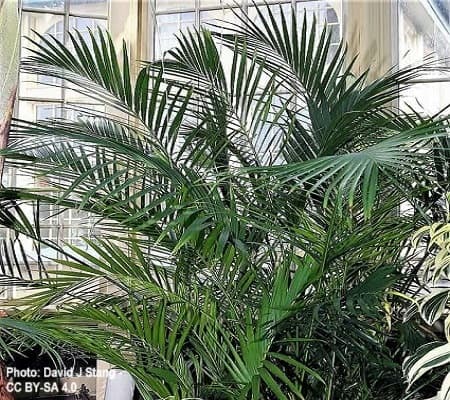 The Cat Palm
The Cat PalmMedium Sized Palm Trees
Medium size palm trees are quite popular.
They're typically between 20-50ft/6-15m tall. Suitable For Backyard Landscapes and garden focal points.
Mexican Blue Fan Palm
Brahea armata is stunning and sturdy.
It grows 30-60ft/9-12m from bottom to top. Hardy to zones 8b-11.
Give it good sun exposure! Medium water needs with good drainage until established. Then low irrigation is fine.
 Sometimes called Mexican Blue Hesper Palm.
Sometimes called Mexican Blue Hesper Palm.Bottle Palm
The Bottle Palm scientific name is Hyophorbe lagenicaulis.
A special accent plant, because of its unusual chubby trunk with a mint green crownshaft.
Slow-growing when newly planted, but will speed up after awhile. Getting up to 30ft/9m. The Bottle Palm zone is best in the warm zones of 10–11, with an average Watering Schedule.
 Bottles have a unique type of palm trunk.
Bottles have a unique type of palm trunk.Queen Palm
Syagrus romanzoffiana has feather-shaped arching fronds, which call out their tropical look.
Best suited for tropical to subtropical zones 9b-11. Depending on its initial seedling starting point (if seedling cautiously exposed to chillier areas), it can go in 8b-9a.
The Queen Palm growth rate is fast. Likes regular good watering - usually the more the better.
 Queens are seen all around Tucson AZ, needing more water in this dry climate. This one is in our neighbor's backyard.
Queens are seen all around Tucson AZ, needing more water in this dry climate. This one is in our neighbor's backyard.Windmill Palm
Trachycarpus fortunei is great for those living in temperate regions.
Windmill Palm height will get 50ft/15m, fairly quickly when well cared-for. For this Palm Known for Cold-Hardiness, zones as low as 7 can be fine. It cannot tolerate hot, tropical climes. Average water requirements.
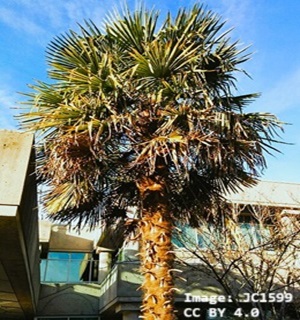 Growing in Vancouver BC, Canada. That demonstrates how cold-tolerant it is!
Growing in Vancouver BC, Canada. That demonstrates how cold-tolerant it is!Large Palm Tree Sizes That Tower into the Sky!
These larger sized palm selections grow over 50ft/15m tall.
- Great for bold, high-impact landscapes.
- Or for bordering lengthy winding driveways.
They're often the type favored by commercial properties and parklands. But can work well in your landscaping, if situated appropriately.
Date Palm
Phoenix dactylifera is tall and statuesque. Reaching up to 90ft/27m.
One of the date palm benefits is the edible fruit you can use for snacks. Or try them in your own recipe creations.
It can cluster into multiple trunks, but often is the solitary type. Likes zones 8b–11 with average rainfall. But Often Grown Commercially in Arid Zones 7b-8a for its drought tolerance.
 Date Palms grow well in Arizona, where this one is.
Date Palms grow well in Arizona, where this one is.Mexican Fan Palm Outdoor is the Only Way!
Washingtonia robusta grows quickly to towering heights.
Yes, up to as much as 100ft/30m. It's the Tall Palm Famed in Los Angeles, where there's a coastal desert climate. Its best zones are 9b–11, although 9a In Warmest Microclimates can work.
It's cousin, The Washingtonia filifera is not quite so tall - getting to 70ft/21m when cared for well. It's nickname is the California Fan Palm.
 Multiple plantings of these tall palms in Tucson AZ - Like These!
Multiple plantings of these tall palms in Tucson AZ - Like These!What Conditions do Palm Trees Need?
Palm trees growing outdoors need to have the conditions that all palms need.
Outdoor palms need sunlight, regular water, to be set into well-draining soil. They also need their Nutritional Needs met. But the essential need is for your to know your Palm Species, to fit your outdoor conditions to its needs.
But the flexibility of palms allows them to grow in many unexpected circumstances.
What is the Cold Hardiest Palm Tree?
We've already mentioned the Windmill Palm, which can take freezes.
Perhaps it's the most cold hardy palm. But it may be tied with, or knocked out of the top by the Needle Palm. Which we'll soon show you.
Plus there's the European Fan Palm which is cold-hardy in Mediterranean types of climates. Are there any other cold hardy palms?
Needle Palm
Rhapidophyllum hystrix is likely the most cold-tolerant of All Palm Tree Species.
It's a Palm Tree in the U.S. that has been native to more northerly states. Like North Carolina, where Palms are Known to Grow. It works all the way down to USDA zone 6b.
A small, clustering palm, it needs regular watering to do its best.
 Frosty night in Florida - the Needle Palm is surviving!
Frosty night in Florida - the Needle Palm is surviving!Heat & Drought Tolerant Palms for Landscapes
We've already mentioned the Mexican Blue Fan and the Mexican Fan Palm, which are tops for hot, arid climates. They tolerate poor soils and only need minimal irrigation.
But Other Palms Do Well in Arid Circumstances.
Salt & Coastal Tolerance
Some palms usually can withstand more than average salty breezes or soils.
These types of outdoor palm trees are ideal for beachside landscapes. The Coconut Palm (Cocos nucifera) is a more common example of this type.
But there are others:
Is Serenoa repens the Same as Saw Palmetto?
The Serenoa repens common name is the Saw Palmetto. So they're the same.
It's native to coastal U.S. states, so development for salt tolerance makes sense.
Slow-growing, eventually gets up to 30ft/9m tall. It also clusters to 12ft/4m wide. Suitable for zones 8-11, 7b can work in the warmest spots.
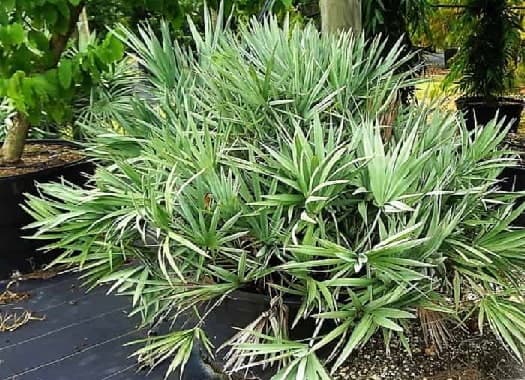 The trunk stays underground while young, just now beginning to rise up.
The trunk stays underground while young, just now beginning to rise up.Buccaneer Palm
Pseudophoenix sargentii is endangered in its native southern Florida.
But can be found for sale, or Grown Carefully From Seed. Best in zones 9b-11, and 9a warm microclimates.
The Buccaneer Palm growth rate is slow. Only producing about 1 new frond per year. Can reach 40ft/12m. Its trunk has handsome rings in newer areas. It's somewhat drought tolerant also.
Typically does well in its native haunts, like the Florida Keys and coastal areas of Northern Caribbean islands. But we know of one growing in Mesa Arizona - yet not as easily or hardily as in the wetter tropics.
 A buccaneer well cared for in Fairchild Garden, Florida.
A buccaneer well cared for in Fairchild Garden, Florida.Cuban Petticoat Palm
Copernicia macroglossa, as you may have figured, is native to Cuba.
A Cuban Petticoat Palm height can get 20ft/6m tall. Lives along coasts and in salt marshes. Ideal for zones 10-11, 9b in warmest areas.
It holds onto its old leaves - so Pruning Off Fully Dead Fronds is okay. It does have a full, thick crown of palmate fronds making it a beauty.
 You can see why "petticoat" is in its common name.
You can see why "petticoat" is in its common name.Which Palm Trees Have Edible Fruit?
Although most palm fruits are inedible, there are edible fruit-bearing palms. including ornamental types of outdoor palm trees.
As we mentioned before, the Date palm has edible fruit. And of course The Coconut Palm Tree with its well-known nut.
But they're not the only ones. Other palms produce fruit that can be plucked off and eaten, too. Yet less than 100 are edible. Here are more commonly eaten palm fruits.
Pindo Palm
Butia capitata is cold hardy, and all-around pretty flexible in needs.
Relatively short, maxing out at 35ft/10.5m. Suitable for zones 9-11 which get regular average rainfall. Add in 8 for dryer areas.
 It has that bonus of sweet edible yellow-orange berry-like fruits that can be made into Pindo Palm Jelly.
It has that bonus of sweet edible yellow-orange berry-like fruits that can be made into Pindo Palm Jelly.Peach Palm
Bactris gasipaes originated around rain forests of Central America.
Ideal climate is zones 9-11, but is known to survive short freezes in 9. Can get 60ft/18m tall, and often clusters.
It's cultivated in South American for the fruit. Which is red-orange when ripe. It tastes dry and mealy, so usually boiled in salted water.
 Peach palm needs more than average water to produce the fruit.
Peach palm needs more than average water to produce the fruit.How to Choose the Right Palm
It's always best to choose the right palm for planting in the right place.
Square up these four factors with your landscaping goals. To choose a palm that beautifully excels for years to come. Consider these overall steps to accomplish that.
1 - Using the USDA Hardiness Zone
Some palms solely want frost-free climates, while others can survive cold winters.
Use weather data to determine your area's lowest cold temperatures. That's how the USDA Hardiness Zone works.
Then match your palm choice to the coldest winter lows in your region. That's how you'll connect your region’s climate to the palm’s hardiness.
Use Your USDA Zone as a starting point.
2 - Know Your Desired Palm's Space Needs
Know your favored palm's need for space at its mature growth height. Since some species remain under 10ft/3m tall while others can exceed 50ft/15m or more at maturity.
- Is your yard small? Then small palms or those in outdoor containers are the choices.
- Towering types are best for wide open landscapes.
- Medium sized types of outdoor palm trees can be used in a variety of gardens.
3 - Consider Sunlight & Soil Preferences
Most palms aren't too fussy about soil. As long as the pH is neutral to slightly acidic. And has good drainage.
Sunlight requirements can be much different for various types of outdoor palm tree species. Think about how much daily sunlight your planting area receives.
- Full sun for tropical heat lovers
- Partial shade for shade-tolerant varieties, usually native to rainforests or understories.
4- Remember Special Considerations
Think of the conditions for your environment and climate.
Weigh your favored palm's special needs:
- Need drought resistance? Choose arid-tolerant palms.
- Coastal property? Pick salt-tolerant types.
- More temperate climate? Pick a cold-hardy palms.
Planting & Care Essentials
Here are some basic Essentials to Know for Planting, and then Maintaining Your Palm.
- Planting Time: Spring time, when there's no more risk of frost. In the tropics and in deserts, winter can be fine, but young palms may need some sun shade protection.
- Soil: Palms aren't too fussy for soil types, though often adding in some loamy substance will be useful. It is essential to ensure your soil drains well, and the pH should be neutral at 7.0 to slightly acidic.
- Watering: Keep soil moist but not waterlogged. Mature palms typically need less.
- Fertilization: Palm fertilizer is best. See more About Fertilizing Your Palm>
- Pruning: Prune off only fully dead palms. See the Best Practices for Palm Frond Trimming>
FAQ for Types of Outdoor Palm Trees
What are the best palm trees for small yards?
What are the best palm trees for small yards?
The Pygmy Date Palm is quite pretty, yet small. The European Fan Palm is another, but it's much more cold-tolerant. These both remain under 20ft/ when fully mature.
Which palms can handle cold climates?
Which palms can handle cold climates?
Several palms are suitable for colder climates, the more temperate zones. Most popular is the Windmill Palm. But the Needle Palm and European Fan Palm can work well in USDA zones as low as 6.
Are there easy-care drought-tolerant palms?
Are there easy-care drought-tolerant palms?
Yes, several palm species do fine with dry conditions. Only needing minimal irrigation after they're established. Consider these:
- California Fan Palm - Washingtonia filifera is a perfect example.
- Saw Palmetto - Serenoa repens can even be Grown From Seed, using a container at least 6in/15cm deep.
- Trithrinax species:
- T. brasiliensis, the Brazilian Needle Palm usually grows to 50ft/15m. Zones 8-11, full sun. Noted for its spiny thick matting along the trunk.
- T. campestris, with several nicknames: Thatch Palm, Blue Needle Palm or Caranday Palm. Zones 7-11 do it well. Quite slowly to 35ft/10.5m at full growth.
Takeaways for types of outdoor palm trees
Palm trees offer an incredible variety of shapes, sizes, and resilience.
Many types of outdoor palm trees are versatile for landscapes in many climates. Whether you're looking for a cold-hardy specimen for a temperate garden or a dramatic focal point for a tropical space, there's a palm that fits your needs perfectly.
Understand the size categories, climate suitability, and care requirements for your chosen species. Then you'll be confident for having the right palm for your setting.

